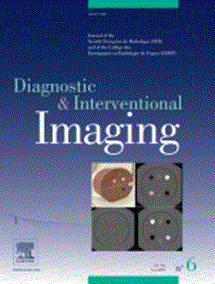经皮图像引导干预的导航和机器人系统评估:先进成像和人工智能集成的新指标。
IF 8.1
2区 医学
Q1 RADIOLOGY, NUCLEAR MEDICINE & MEDICAL IMAGING
引用次数: 0
摘要
目的:导航和机器人系统旨在提高经皮图像引导干预的准确性和效率,但缺乏对其自主性的评估以及先进成像和人工智能(AI)的整合。本研究的目的是评估用于经皮图像引导干预的导航和机器人系统中先进成像和人工智能的自动化和集成水平,使用已建立的和新颖的指标对其能力进行分类和比较。材料和方法:遵循PRISMA指南,对2000年至2024年5月期间发表的经临床验证的导航和机器人系统的研究进行了系统回顾。检索了PubMed、Embase、Cochrane Library和Web of Science数据库。对导航设备上的数据进行提取和分析。采用手术机器人(LASR)分类系统中的自主性等级(1 ~ 5)来分析自动化程度。我们创建了一种新的分类法,即高级成像与人工智能整合水平(LIAI2)分类系统,对成像技术与人工智能的整合进行分类(从1到5)。这两个分数被合并成一个总分(从1到10),以反映经皮图像引导干预的自主性。结果:该综述包括20项研究,评估了两种导航系统和8种机器人设备。LASR得分中位数为1 (Q1, Q3: 1,1), LIAI2得分中位数为2 (Q1, Q3: 2,3),总得分中位数为3 (Q1, Q3: 3,4)。只有一个机器人系统(占审查机器人系统的10%)达到了文献中最高的LASR资格,即2/5级。四个系统(40%)分享了LIAI2的最高评级,得分为3/5。四个系统(40%)获得了最高的总分4/10。结论:导航系统和机器人系统均未达到经皮图像引导介入治疗的完全自主性。LASR和LIAI2量表可以通过确定进一步发展和整合的领域来指导创新。本文章由计算机程序翻译,如有差异,请以英文原文为准。
Evaluation of navigation and robotic systems for percutaneous image-guided interventions: A novel metric for advanced imaging and artificial intelligence integration
Purpose
Navigation and robotic systems aim to improve the accuracy and efficiency of percutaneous image-guided interventions, but the evaluation of their autonomy and integration of advanced imaging and artificial intelligence (AI) is lacking. The purpose of this study was to evaluate the level of automation and integration of advanced imaging and artificial intelligence in navigation and robotic systems for percutaneous image-guided interventions, using established and novel metrics to categorize and compare their capabilities.
Materials and methods
Following PRISMA guidelines, a systematic review was conducted to identify studies on clinically validated navigation and robotic systems published between 2000 and May 2024. The PubMed, Embase, Cochrane Library, and Web of Science databases were searched. Data on navigation devices were extracted and analyzed. The levels of autonomy in surgical robotics (LASR) classification system (from 1 to 5) was used to analyze automation. A novel taxonomy, the Levels of Integration of Advanced Imaging and AI (LIAI2) classification system, was created to categorize the integration of imaging technologies and AI (from 1 to 5). These two scores were combined into an aggregate score (from 1 to 10) to reflect the autonomy in percutaneous image-guided intervention.
Results
The review included 20 studies assessing two navigation systems and eight robotic devices. The median LASR score was 1 (Q1, Q3: 1, 1), the median LIAI2 score was 2 (Q1, Q3: 2, 3), and the median aggregate score was 3 (Q1, Q3: 3, 4). Only one robotic system (10 % of those reviewed) achieved the highest LASR qualification in the literature, a level 2/5. Four systems (40 %) shared the highest rating for LIAI2, which was a score of 3/5. Four systems (40 %) achieved the highest aggregate scores of 4/10.
Conclusion
None of the navigation and robotic systems achieved full autonomy for percutaneous image-guided intervention. The LASR and LIAI2 scales can guide innovation by identifying areas for further development and integration.
求助全文
通过发布文献求助,成功后即可免费获取论文全文。
去求助
来源期刊

Diagnostic and Interventional Imaging
Medicine-Radiology, Nuclear Medicine and Imaging
CiteScore
8.50
自引率
29.10%
发文量
126
审稿时长
11 days
期刊介绍:
Diagnostic and Interventional Imaging accepts publications originating from any part of the world based only on their scientific merit. The Journal focuses on illustrated articles with great iconographic topics and aims at aiding sharpening clinical decision-making skills as well as following high research topics. All articles are published in English.
Diagnostic and Interventional Imaging publishes editorials, technical notes, letters, original and review articles on abdominal, breast, cancer, cardiac, emergency, forensic medicine, head and neck, musculoskeletal, gastrointestinal, genitourinary, interventional, obstetric, pediatric, thoracic and vascular imaging, neuroradiology, nuclear medicine, as well as contrast material, computer developments, health policies and practice, and medical physics relevant to imaging.
 求助内容:
求助内容: 应助结果提醒方式:
应助结果提醒方式:


